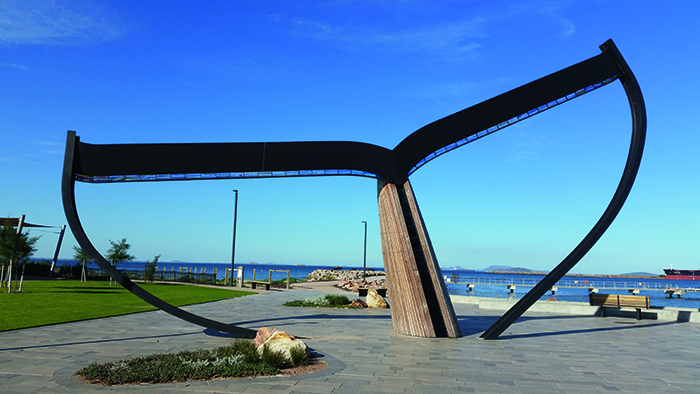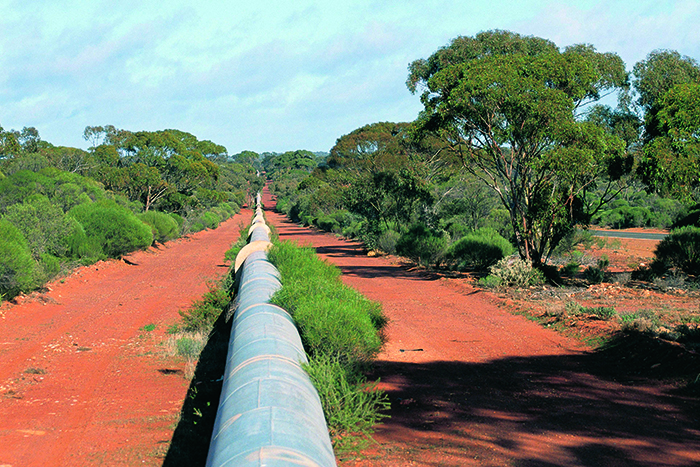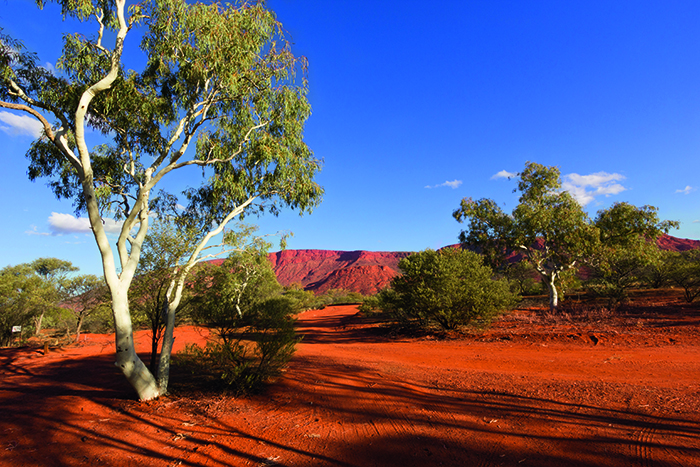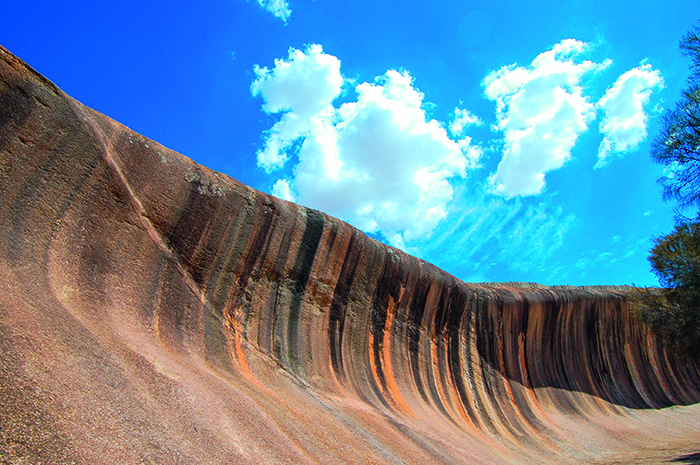From arid country filled with the history of Western australia’s gold-rush past, through to coastal National Parks, and world-renowned hotspots of biodiversity, visitors to the golden outback will truly strike it lucky.
BE CAPTIVATED BY THE FITZGERALD COAST
Covering an area of approximately 330,000 hectares, the Fitzgerald River National Park is one of the largest and most botanically significant national parks in Australia. Located on the central south coast of WA, within the Great South West Edge – an area recognised for its extraordinary biodiversity – the region spans the towns of Ravensthorpe and Munglinup, between Bremer Bay and Hopetoun.
Intriguingly, the park was considered worthless by early explorers to the area. Today, it is renowned for its diverse and spectacular scenery, with more than 1800 beautiful and bizarre flowering plant species, as well as myriad lichens, mosses and fungi all recorded in its bounds. That's almost 20 per cent of the total number of plant species in Western Australia.
A leisurely seven-hour drive from Perth, this pristine coastal treasure is ideal for the traveller wanting to experience something out of the ordinary while enjoying the kind of quiet and solitude that's impossible to find nearer the city. The state and federal governments recently spent $40 million on a sealed road into the park, with beautiful viewing points, interpretive signage and a whale-viewing platform at Cave Point.

Quoin Head, Fitzgerald National Park.
Hopetoun – the gateway to the national park – has a laid-back atmosphere that you can't help but relax in. With a number of accommodation options for the discerning traveller, as well as restaurants and cafes, the town is well worth stopping at on the drive through to Esperance. Stay at Wavecrest Village, which hosts quality three-bedroom, two-bathroom chalets, a swimming pool, barbecues and a caravan site that can take everything from the largest vehicle down to the smallest tent. Wavecrest's menu caters for all tastes, with bar facilities and an outside beer garden making it easy to unwind after a day of exploring.
Hopetoun itself is packed with things to do. Why not indulge in fish and chips while you watch the western sun drop below the Barren Ranges? Cave Point, Hammersley Inlet, and Whalebone Beach campsite are all essential sights
to see within the park, while an easy walk up Mount Barren is a must-do. Those with an off-road vehicle can drive out to the Hamersley sand dunes, and the more robust traveller can take the Southern Ocean Road into Mason Bay, onto Starvation Bay and continue on via Munglinup to Esperance.
Characterised by captivating contrasts between the land and sea, the Fitzgerald Coast is a truly unique national landscape, offering diversity at its finest.
For further information on planning your holiday to the Fitzgerald Coast, visit
www.fitzgeraldcoast.com.au
STEP BACK IN TIME ON THE GOLDEN QUEST DISCOVERY TRAIL
Yearning for a taste of the Australia of old? A place where people speak with a refreshing honesty, where passing another car counts as traffic, and where natural landscapes stretch unencumbered to the distant horizon beyond?
The 965km Golden Quest Discovery Trail transports you to such a world. This self-drive adventure stretches from Coolgardie in the south to Leonora in the north. Stop at 25 interpretive signage points along the way to gain an appreciation of the hardy outback characters who pioneered the land and helped shape its character today – you'll learn about their ingenuity, their tenacity, their triumphs and their tragedies.
Coolgardie was the first township established in the region during the late 1800s rush to find gold. Thousands of people descended on the area in those early days, driven by dreams of striking it lucky. While life was tough, those who prospered went on to erect the gorgeous buildings that continue to adorn Coolgardie today.

Photography Jane and Michael Pelusey.
Coolgardie is also starting point for a new addition to the Golden Quest Discovery Trail. The Green Trail traverses part of the Great Western Woodlands – a mind-boggling 16 million hectares recognised as the biggest intact remnant of temperate woodland on the planet.
Heading north you'll discover the outback city of Kalgoorlie. Sitting at an historic pub on the grand main street, sipping on a cold beer, you can almost picture the city as it once was, with horses and carts trundling up the road and the streets abuzz with rumours of the latest gold discoveries.
While Kalgoorlie continues to buzz with life, other towns further north have been abandoned, along with the search for gold. The nearby ghost towns of Gwalia and Kookynie are striking examples – whole settlements still standing in virtually the condition they were abandoned, all dust-cloaked buildings and rusting corrugated iron. Visit these townships today, learn a little about their past, and imagine them in their prime, during an era bustling with promise and fantasies of finding a fortune.
No drive along the Golden Quest Discovery Trail is complete without visiting Lake Ballard and its striking sculptures. Here, black human figures appear like mirages from their salt-lake surrounds, eerie desert sentinels. Famed sculptor Antony Gormley created the sculptures for a temporary exhibition, but they were so wildly popular that they've remained as a permanent exhibit.
For more information on the Golden Quest Discovery Trail, or to buy a guidebook, visit the website www.goldenquesttrail.com
HAVE A WHALE OF A TIME IN ESPERANCE
A brand new, world-class waterfront has put Esperance on the map for locals and visitors alike. Providing a seamless transition from the Esperance town centre to the waterfront, the 20-month transformation has given the foreshore a stunning new-look, with improved recreational and community space. Concrete sea walls, barbecue areas, access to beaches, picnic shelters and playgrounds are all key features of the new development, making it the perfect spot to bring the family or simply relax by the beach.
The Shire of Esperance has said the new waterfront has created an enormous sense of community pride. "We are really proud of our new waterfront, it has truly enhanced the vibrancy of our town. On any given day you can see people strolling along it, runners, people walking their dogs, and others simply enjoying the view. It is very satisfying to see the waterfront being so well used and enjoyed by the community."
Newly installed along the foreshore is the whale-tail sculpture, which has quickly become a popular landmark. The notable piece of public art combines the artistic talent of Esperance artists Jason Wooldridge and Cindy Poole, who says the sculpture was inspired by the Southern Right Whales that come near to shore in Esperance throughout the winter.

The whale-tail sculpture on Esperance foreshore.
"When a tail is seen, it is usually just a very graceful and mellow rise and sinking of the fluke," Cindy says. "It is this that has been an inspiration for the sculpture. The tail is symbolic of the ocean's importance to this area." The iconic feature can be seen at the James Street Precinct.
The Great Ocean Drive, the town's connection to the sea continues back into town, through some of Esperance's most spectacular attractions. Take a walk around the Rotary Walk Trail and engage with the landscape. Pack a picnic and find one of the secret huts around the rock. Walk, run or cycle the new waterfront and beach trails, dive through crystal-clear water, explore the granite headlands or simply reflect while enjoying the sea spray.
The Esperance Municipal Museum is another unique part to the town – and what you see there might surprise you. The museum holds a unique piece of history in the shape of Skylab. Large pieces of the fallen space station are on display in the museum, along with other material from NASA.
Whether you're after an ocean view, a casual cafe experience, or a pizza and a beer, there is plenty of choice for dining in Esperance. Check out the options and enjoy the atmosphere every night of the week.
A BYGONE ERA AT GWALIA
Step onto a silent street in Gwalia, and you're hurtled back in time. This ghost town near Leonora stands virtually how it was abandoned – its corrugated iron homes cloaked in decades of dust, and the whispers of ghosts on the breeze. The township was deserted in 1963 when gold miners and their families abandoned their homes after the closure of the Sons of Gwalia Mine.
Forced to pack up overnight to catch one of three trains sent to collect them, they left with only what they could carry. The resultant ghost town acts as a startlingly vivid glimpse into a bygone era. You can wander along the main street today and peer into the old store, the crumbling buildings, and homes fashioned from rusting corrugated iron and hessian.
You can step inside some buildings and imagine life as it was – when women worked in the kitchen while their men toiled in the mine. Despite the unforgiving environment and the isolation, those who once lived here remember it as a bustling community full of life – with sporting events, dances, balls and dress-up parties.

The remains of the town of Gwalia.
Visitors can learn more at the Gwalia Ghost Town Museum. There's an interactive map to download to your tablet or smartphone, on which you can learn more about the buildings and the people who once lived here (www.gwalia.org.au).
Those wishing to stay can do so at the historic Hoover House bed and breakfast, built more than 100 years ago by Herbert Hoover – a young mining engineer who later went on to become America's 31st President. The house is near the abandoned Sons of Gwalia open-pit mine: enjoy a coffee on the verandah and imagine the men who once worked here, the families who lived here, their hopes, their dreams, their daily lives.
GETTING TO THE GOLDFIELDS IS PART OF THE ADVENTURE
Immerse yourself in one of Western Australia's most colourful historical chapters by following in the footsteps of the hardy men and women who ventured into
the Goldfields in the late 1800s. The Goldfields and roads leading to the area are blessed with a series of self-drive trails that bring to life the stories of the region's rollicking past.
From Perth, you can set out on the Golden Pipeline Heritage Trail to the Goldfields. The trail follows the route of the pipeline that transformed the Goldfields by transporting life-giving water from Perth's forest-cloaked hills, 600km to the state's desert heart. The trail includes stops at former steam-driven pump stations, and 25 interpretive sites that share the stories of this engineering marvel and its creation. You can also purchase a guidebook to further open your eyes to the wonders of this region and its history.

The Goldfields Water Pipeline.
You'll learn the heartbreaking story of CY O'Connor, who envisaged the pipeline, only to become dogged by criticism and controversy. You can also access the Goldfields on an alternative route to Kalgoorlie, via Hyden and Norseman, on the Granite Woodlands Discovery Trail. This good-quality but unsurfaced road travels through one of the world's biggest intact temperate woodlands – an enchanting world of trees and wildflowers, heathlands and granite outcrops. Some 16 interpretive sites tell tales of natural and historical intrigue along the journey.
To really soak up the trail's natural beauty, be sure to take one of the several walk trails or stay at a camping spot. It's by slowing down, breathing the clean country air and getting up close to nature that you can properly experience its magic.
Once you reach the Goldfields on the Granite Woodlands Discovery Trail, you can then set out on the Golden Quest Discovery Trail from Coolgardie to Laverton to launch into another world of adventure – this time following in the footsteps of the early gold prospectors who brought the region to life with their dreams of striking it lucky.
For more information on self-drive itineraries to the Goldfields visit www.australiasgoldenoutback.com
TASTE OF COUNTRY LIFE AT KUKERIN
When it comes to getting away from it all, and soaking up Mother Nature's splendour, it's hard to beat a trip to Cambinata Yabbies near Kukerin.
Thanks to the magnificence of the annual Cambinata Yabbies Extravaganza – a sumptuous fine dining experience held in a rustic shearing shed – this Wheatbelt getaway has long been known as offering something extra-special.
And now, with the recently opened Mary's Farm Cottages, the family-run business again has tongues wagging for all the right reasons.
The eight self-contained cottages form an 'eco-village' with full solar energy, rainwater collection and recycled grey water used to maintain the lawns. Truly, the cottages are in a class of their own.

Mary's Farm cottages, Kukerin.
Visitors are drawn to Cambinata by the solitude, the wildflowers, the yabbies, the trees, the sunsets, and the simplicities of farm living. Many order gourmet yabby dinners, delivered direct to their cottage, or lunches served in the shearing shed decorated with historic relics, Aboriginal art and a grand piano.
Guests also rave about the barbecue, which is located under the bonnet of an ancient Austin truck, with the truck's tray providing a great picnic table. Many set out on a tour of the yabby farm – the country's only licensed yabby export processing facility. Some duck into Kukerin for a meal at the historic pub, and others visit the nearby Emu Farm. The farm makes a great stopover on the way to Esperance, and is positioned within about 90 minutes of attractions such as Wave Rock, the Stirling Ranges, Lake Grace and Wagin.
For more information visit the website www.marysfarmcottages.com.au
MYSTICAL MOUNT AUGUSTUS
You'll see Mt Augustus long before arriving at its base. This slumbering geological giant looms 715m above the stony red heart of the Gascoyne, and its mighty form sprawls 8km across the land. An almost surreal presence on an otherwise flat horizon, this hunk of rock and earth is twice the size of its more famous cousin, Uluru. And, like Uluru, it plays an important role in Aboriginal mythology.
The Wajarri people of the area call the mount Burringurrah, after a boy from the Dreamtime. During this mystical age, the young boy Burringurrah shirked the responsibilities of his tribal initiation, sparking the wrath of his tribal elders, who speared and clubbed him to death. The Wajarri say Mt Augustus shows the shape of the boy as he lay dying on his stomach, with his left leg bent up beside his body. The rock formations on the west side of the mount show his wounds.
You can experience the mount's mystical nature on a 49km drive around its base. Stop at lookouts, gorges and several sites that are home to ancient Aboriginal art.
You can also set out on a series of walk trails around the mount, ranging from a short 250m trail to one- and two-hour hikes and the epic six-hour, 12km-long hike to the summit.

Mt Augustus.
For a spectacular view of the mount, head to nearby Emu Lookout at sunset. Bring a drink and some nibbles, and sit back to watch the light show unfold on the mount before you – an ever-changing dance of purples, reds and golds. Also be sure to visit nearby Cattle Pool. This permanent gum-lined pool on the Lyons River boasts a riot of birdlife, and is the ideal place for a picnic.
Mt Augustus is a star attraction on the Kingsford Smith Mail Run – one of the three self-drive trails with interpretive signage that make up the Gascoyne Murchison Outback Pathways. Really immerse yourself in the region's mystical nature by staying a while at Mt Augustus Tourist Park.
WONDERS OF WAVE ROCK
If you're a Western Australian you've no doubt heard of Wave Rock... but have you actually experienced this natural phenomenon yourself? It's not until you stand at the foot of the mighty rock formation that you can properly experience its wonders.
Here, looming 15m above you, a 110m length of rock appears like a cresting wave frozen in time. Standing in front of it, you cannot help but wonder at how the wave-shaped rock was created, what extreme forces of nature conspired to shape its current form. Apparently its formation dates back a mind-boggling 2700 million years, even before the time of the dinosaurs.
But a visit to Wave Rock is not just about the rock itself. If you set out on the Pathways to Wave Rock drive from Perth you'll find a whole world of quaint and quirky discoveries await you. Following the drive transports you on a looped journey from and to Perth, bypassing eight central Wheatbelt townships, with Hyden and Wave Rock at the eastern end of the loop.

Wave Rock, Hyden.
Along the way you'll pass outback oddities like the delightful Tin Horse Highway. Here, along a dusty stretch of road outside Kulin, locals have been erecting tin horses in a quirky show of country art. The creation began with a single horse to help promote the Kulin Bush Races, but more and more horses have been popping up ever since.
Similarly intriguing is Corrigin's Dog Cemetery: established in 1974, it is now the last resting place of more than 80 dogs. Wander among the headstones, read the inscriptions and you'll find the notion of dogs being man's best friend has never seemed more appropriate.
Natural marvels also abound along the drive. Kokerbin Rock looms high above the landscape, affording striking views of the rolling paddocks and bush. Set out on a walk trail here to soak up its natural beauty.
The Humps, near Hyden, are equally interesting, brooding hulks of granite rising from the surrounding plains. The Humps are home to Mulka's Cave, where Mulka the Terrible once lived. Aboriginal art adorns the cave's dark reaches, and interpretive signage tells the gruesome Aboriginal legend of Mulka himself. It's enough to make you shiver.
For a map and information about attractions along the pathways, download a Pathways to Wave Rock brochure kulin.wa.gov.au/file/2013PathwaystoWaveRockBrochure.pdf